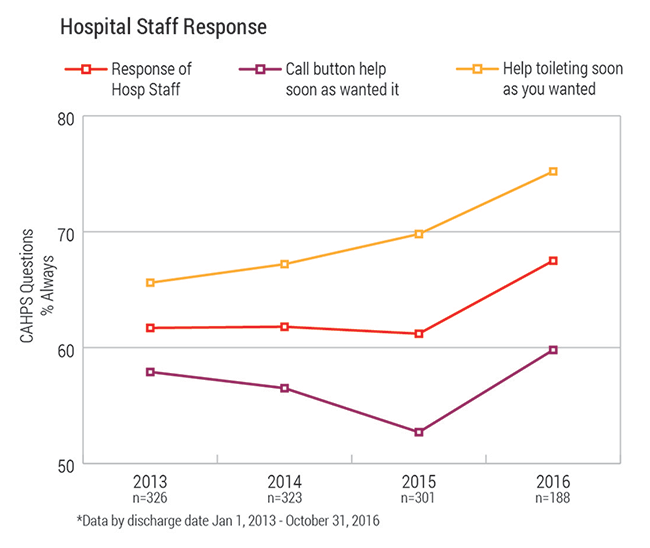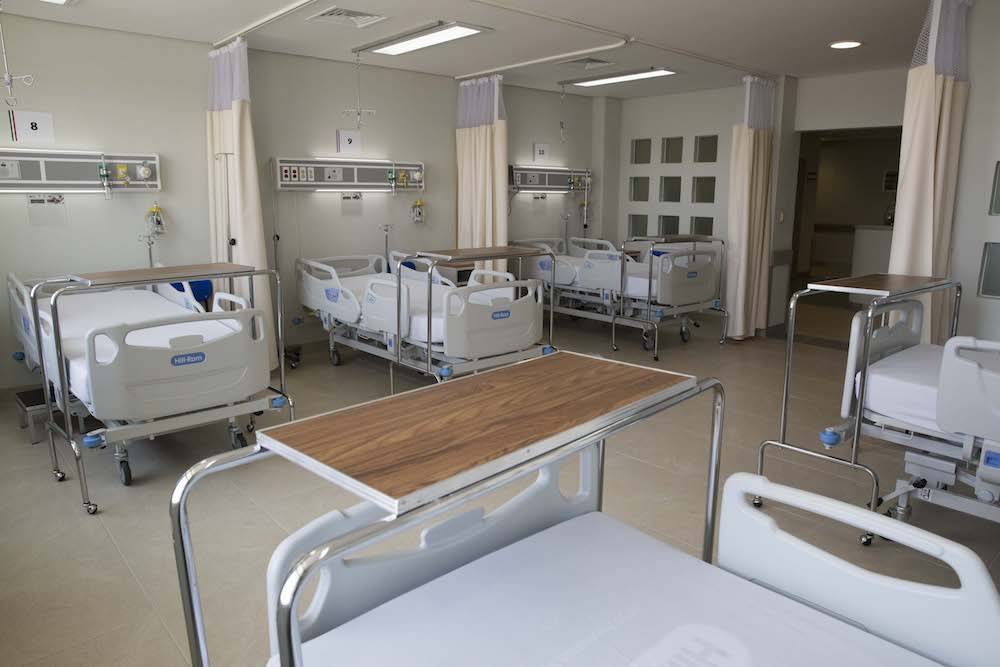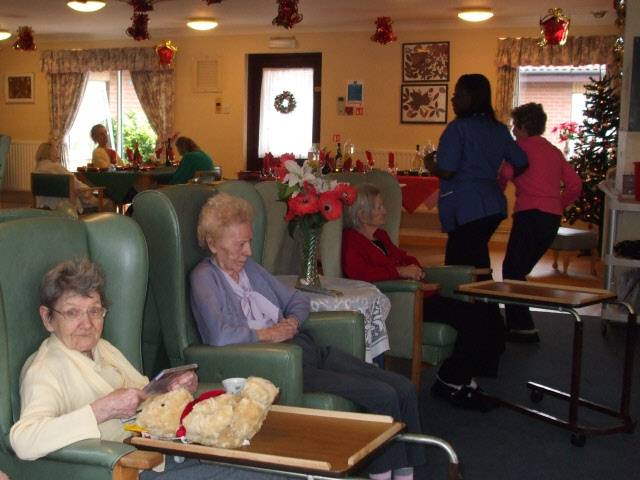The list below gives 15 ways to improve HCAHPS scores. It addresses performance to the HCAHPS questions.
The survey itself measures patient satisfaction. Low scores hurt a hospital or nursing home in two ways. First, by damaging the facility’s reputation, since scores and star ratings for hospitals can be compared by patients online when deciding on a care location.
Second, low HCAHPS scores can decrease a hospital’s Medicare/Medicaid reimbursement through CMS by as much as 2% for 2017.
What is HCAHPS?
HCAHPS (or the Hospital Consumer Assessment of Healthcare Providers and Systems) is basically a report card for hospitals, graded by the patients. It also covers nursing homes and other care facilities.
The assessment asks 32 simple questions, all concerning different aspects of a hospital stay. These include interaction with doctors and nurses, housekeeping, pain management, and so on.
The HCAHPS survey has been used since 1995, though reimbursement penalties have increased in recent years. It’s supervised by the Agency for Healthcare Research and Quality (AHRQ). There is also a Clinical Group survey called the CGCAHPS, as well as separate surveys for ambulatory surgery and hospice.
The purpose of the HCAHPS is to gives hospitals a quality grade. Higher scores on the assessment survey increase a facility’s reimbursement.
What’s the HCAHPS Survey Like?
The HCAHPS assessment survey consists of 32 simple questions. The first 17 are formed as “how often” questions, such as “How often were your room and bathroom kept clean?” The multiple-choice answers are Never, Sometimes, Usually, and Always.
The rest of the questions are Yes/No or other multiple choice.
The topics of the questions break down like this:
- 7 questions about the patient’s ethnicity, education, and other personal details.
- 7 questions on patient education for discharge preparation.
- 4 questions about nurse interaction and speediness.
- 3 questions on doctor interaction.
- 3 questions on patient medication education.
- 3 questions about pain management.
- 2 questions on housekeeping and noise levels.
- 2 questions on assistance with bathroom needs.
- 2 questions concerning general hospital rating.
All HCAHPS Assessment Questions 2017
A clinic, private practice, or hospital that wants to improve HCAHPS scores can start by knowing the questions.
You can download an HCAHPS PDF survey sample here. This is the official document used to grade hospitals for 2017.
Facilities looking to improve their scores often make these questions the subject of their staff meetings. This practice not only identifies low-hanging fruit for doing better on the assessment, but it also keeps the questions top-of-mind to improve day-to-day staff performance.
Ultimately, the goal for boosting HCAHPS scores is better patient care, higher reimbursement, and a better reputation for the facility.
How Much Is Hospital Reimbursement Based on HCAHPS Patient Satisfaction?
The biggest reason to improve HCAHPS scores of course is patient satisfaction. In health care, patient care is tantamount.
But there’s another reason to boost survey scores as well. HCAHPS assessment scores are tied directly to reimbursement.
The financial incentive around the survey intends to improve the overall standard of care in the nation. The reimbursement for 2017 puts 2% of a facility’s compensation at risk depending on the survey scores.
In 2015 and 2016, patient satisfaction only accounted for 1.5% of reimbursement. As a result of recent increases, hospitals have altered their focus to include customer satisfaction with an already high standard of care.
Which Patients Participate in HCAHPS
Any patient can participate in the HCAHPS survey, provided they:
- Are 18 years old.
- Are alive at discharge.
- Had at least one stay overnight as an inpatient.
- Are non-psychiatric and non MS-DRG diagnosis at discharge.
The hospitals themselves choose patients for the survey at random. Large hospitals should choose the patients surveyed at random. Small hospitals should survey all eligible discharges. Hospitals then submit data from the survey to the HCAHPS data warehouse. CMS then analyzes the data to arrive at a final score.
How to Compare HCAHPS Scores
Anyone can compare HCAHPS scores by State or by hospital by visiting the Hospital Compare website. The site gives star ratings for each hospital or nursing home.
Beyond improving reimbursement figures, one big reason to seek ways to improve HCAHPS scores is to get a higher star rating or score for marketing purposes.
In today’s internet-centered environment, savvy patients can look at a facility’s 2017 HCAHPS star rating before deciding on a nursing home or hospital for care.
Via: Wikimedia Commons
15 Ways to Improve HCAHPS Results
The HCAHPS assessment survey provides a score that figures on a hospital’s reputation and reimbursement. As such, it’s in a hospital’s best interest to improve its score as much as possible.
Below are 15 ways to improve HCAHPS scores. Raising results through better patient satisfaction can mean a better reputation. A higher star rating also means more reimbursement dollars for the facility at large.
1. Make Sure Nurses Treat Patients with Courtesy and Respect
The first of the 27 questions on the HCAHPS Survey concerns nurse courtesy. The good news is, nurses generally have good bedside manner to begin with. However, fast-paced hospitals and clinics can put a crimp in courtesy over time.
To combat the problem and score high on the survey, make sure nurses follow these easy tips:
- Introduce yourself.
- Explain your role in the patient’s care.
- While speaking with the patient, sit.
- Make eye contact.
- Practice empathy and listening.
2. Ensure that Nurses Listen to Patients
We’re not picking on nurses here. It’s just that the first four questions on the HCAHPS Survey center around nursing staff. (We’ll get to doctors in a minute.) The second question on the survey focuses on listening. Namely, how often did the patient feel the nurses listened carefully?
According to Forbes, we can improve our listening skills by making eye contact, relaxing, avoiding interruption, and trying to picture what the speaker is saying. We can also give feelings-based feedback during natural pauses, such as, “That must be awful,” or “You must be really thrilled!”
3. Make Sure Nurses Explain Patient Care Clearly
The third item on the HCAHPS questions list concerns how often nurses explained care plans clearly to the patient. Being in a hospital can be a terrifying prospect. Though constant explanations may seem tedious to staff, they’re a big part of a hospital’s final survey score.
Review materials and procedures with the patient. Understand that some patients prefer DVDs for education, while others like spoken or written instruction. All patient education should start from a “what’s in it for the patient” motivation.
4. Empower Speediness in Nurses
This is the last time we’ll pick on nurses. That’s a promise!
Question #4 on the HCAHPS Survey asks the patient how often nurses responded promptly to a pressed call button.
Patients can’t see how busy nurses are, or whether certain staff are busy restocking supplies or chasing down a special order from a doctor. Interestingly, nurses at the University of Utah’s Surgical Specialty and Transplant Unit (SSTU) improved nurse response time by lowering the frequency of call-button presses.
In other words, they anticipated patient needs, then followed a set of procedures that included better listening, asking patients if their phones were fully charged, and telling patients exactly what time they would return.
The result? Scores shot up 20%-30% on their HCAHPS scores.

5. Improve Doctor Respect and Courtesy
Now it’s time to pick on doctors for a few HCAHPS questions. Question #5 on the survey asks the patient how often doctors embodied respect and courtesy.
Getting patients to feel respected can be challenging in a fast-paced hospital or clinic. Listening with empathy and treating patients how you’d want to be treated are two reliable tools.
Need more doctor/patient trust tips to improve your HCAHPS score? See our guide: “How to Get Your Patients to Trust You [Tips + Examples]“
Find Out How Much You Can Save Instantly.
Try our on-line savings calculator.
6. Make Sure Doctors Listen to Patients
The HCAHPS asks patients, how often did your doctors listen carefully to you? This question tries to get at whether doctors really understand what’s going on, or if they’re just applying a cookie-cutter approach.
A doctor’s job is to heal, not make patients feel coddled. But to get higher scores on the survey, it’s important to use active listening. That means making eye contact, repeating back the patient’s concerns, and then explaining how you’ll address the problem.
7. Have Doctors Explain things Clearly
Patient education isn’t just for nurses. Doctor/patient education is a factor on the HCAHPS survey. One question asks how often doctors explain things in a way the patient could understand.
How can doctors improve patient education when they’re already so strapped for time they can’t even stop for lunch? Delegating “other” responsibilities can free up time for patient education. Also, work from what the patient knows already. A simple question like, “How much do you know about your condition?” can reveal the patient has it 75% right. Then the doctor can focus on the 25% that needs correcting.
8. Keep it Tidy
Since one of the HCAHPS questions asks how often the patient’s room and bathroom were kept clean, housekeeping is vital. Regular visits to take out trash or clean up spills can go a long way toward improving survey scores. Another big factor patients cite in related questionnaires is meal trays. Having a dirty breakfast tray in the room until lunch can really rumple a patient’s johnny.
Also, consider discussing HCAHPS goals in every staff meeting. Once all staff members know it’s their responsibility to address obvious untidiness, scores invariably improve.
9. Keep it Quiet
Hospitals and nursing homes are noisy places. The “machine that goes bing” can do so all night long. Patients in pain or otherwise disruptive patients exacerbate the problem.
Management needs to commit to a “culture of quiet.” That means supporting staff efforts with time and funds. Soliciting ideas from nurses and other staff can uncover low-hanging fruit in the battle to improve HCAHPS results. Assess machinery around the patient and the necessity of each medical alarm. Take noise into account during future purchasing decisions.
10. Prioritize Mobility
Most hospitals do an excellent job of making bathrooms and bedpans accessible. Handrails and wide bathrooms make it easy for the patient to get relief when needed. Facilities that score low on the HCAHPS survey should question their accessibility.
Could patient bathrooms be made more accessible? If not, staff can schedule patient bathroom visits, and educate the patient about exactly when they will occur. Scheduled, posted bathroom assistance times can go a long way toward boosting a patient’s assessment of a hospital.
11. Take a Different Approach to Patient Pain
The nature of pain medication means it’s sometimes impossible to provide enough. Long-term patients may feel jilted by habituation. There’s even evidence that patient satisfaction surveys like the HCAHPS may have a hand in fueling the country’s opioid addiction.
High-quality pain management systems ensure appropriate assessment, family input, and include non-pharmacological therapies. Regular pain evaluation and reassessment can catch a deteriorating trend before it’s too late.
12. Include Medication in Patient Education
Two important HCAHPS questions center around medication education. A hospital, clinic, nursing home, or private practice can improve survey scores by making sure:
- Patients are well educated about each medication’s purpose.
- Staff clearly explains the common side effects of medicines.
The survey aims to learn whether a hospital is giving medications to its patients “sight unseen,” or whether patients fully realize what they are getting into with each drug they take. Taking the time to brief a patient on the purpose and potential problems from each injection, pill, and drip can mean higher patient satisfaction at discharge time.
13. Tell Patients How You’ll Help Them Afterward
Most patients don’t expect help from the hospital after they’ve gone home. It can come as a surprise to doctors, nurses, and other staff that some patients do expect assistance to continue.
Since continued help shows up in several HCAHPS questions, this can be a big area to improve HCAHPS scores. Make sure a representative of the hospital discusses post-hospitalization help. Even if no help will be available, ensure the patient understands that. Getting higher survey scores can be as simple as running through a simple questionnaire like this with patients:
- Do you have someone to help you at home?
- Will you need help getting to the bathroom?
- Do you have someone to prepare your meals?
- Can you call on family or friends if you need help?
- Do you have arrangements for in-home care?
14. Talk Future Symptoms with the Patient
Educating patients about symptoms to look out for is yet another way to see a jump in HCAHPS scores. One of the survey questions concerns symptoms and health problems to watch for in the coming days, weeks, or months.
Specifically, the survey asks the patient whether information about possible symptoms was provided in writing. Anyone who’s stayed in a hospital knows what happens at discharge time. The patient is given a fat binder full of supplementary materials.
Since future symptom education is a critical area on the survey, consider making it a regular discharge duty. This can be as simple as a staff member sitting down and telling the patient, “tape this list of symptoms to your bathroom mirror at home. If you have any of these symptoms, call us.”
15. Don’t Ignore the Patient’s Family
What does a patient’s family have to do with scoring higher on the HCAHPS? Plenty. As disruptive as family can seem, patients often depend on family members as their staunchest advocates.
One of the survey questions asks whether the staff took family preferences into account when deciding on health care needs. The solution? Make sure doctors and nurses use their listening and empathy skills on family members as well as patients.
Conclusion
The HCAHPS survey is a report card for nursing homes and hospitals, graded by the patients, based on patient satisfaction.
A low star rating can mean up to 2% less Medicare/Medicaid reimbursement for 2017. It can also mean less patients, since savvy consumers are learning they can compare hospitals by HCAHPS scores online.
Ultimately, any hospital or other healthcare facility can raise its HCAHPS scores by paying attention to a few key areas. Focusing staff efforts on improving patient education, nurse and doctor interaction, housekeeping, noise levels, and bathroom assistance can greatly affect customer satisfaction and ratings.
The 15 ways to improve HCAHPS scores above provide an excellent focus for facilities seeking to improve their reputation and reimbursement. Making them the focus of staff meetings can set a hospital or nursing home on the path to patient satisfaction excellence.
See how much your facility could save on Biohazard Waste Disposal by trying out the savings calculator below.




